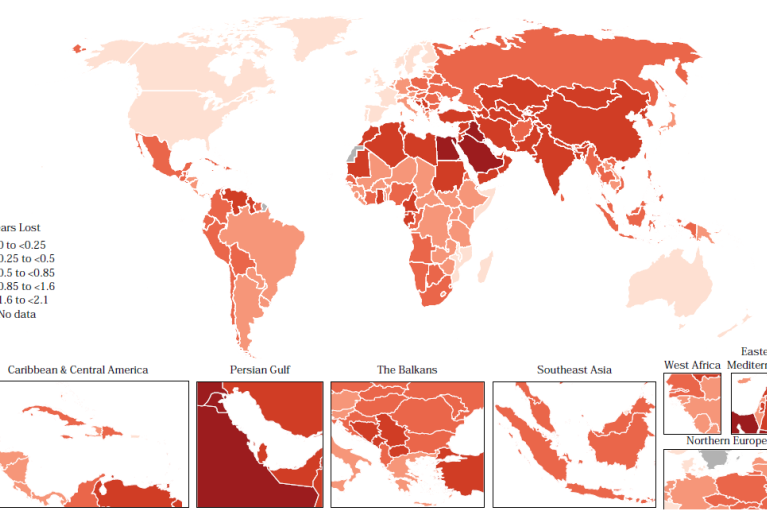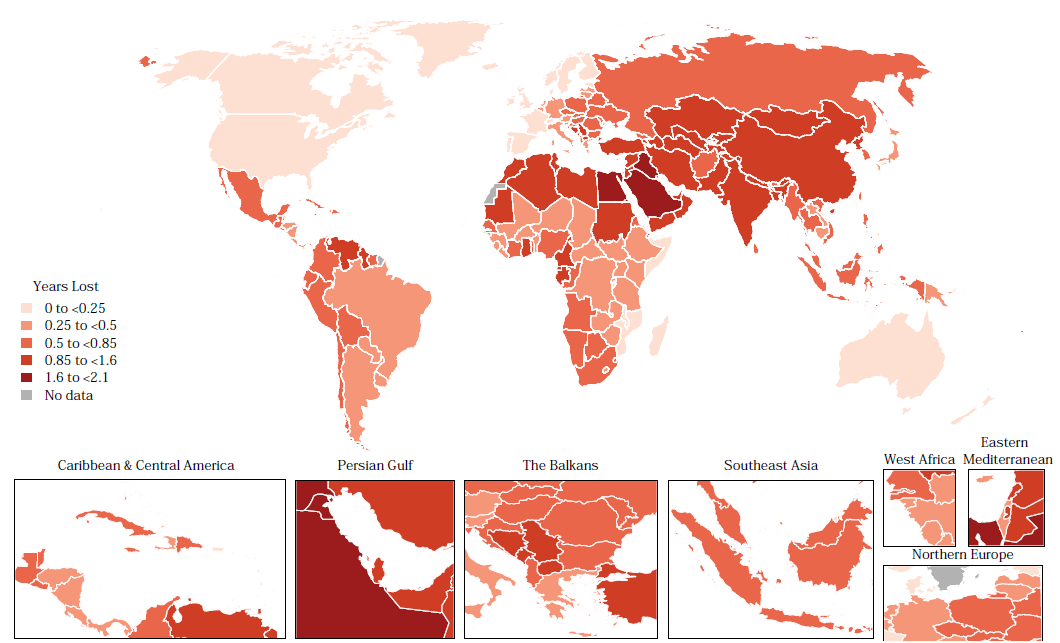Years of life expectancy lost due to air pollution in 2019. Scroll over to see the data for individual countries.

IMPACTS IN CONTEXT
Air pollution’s impact on life expectancy is comparable to other major drivers of death and disease.

EXPLORING THE DATA
The relationship between pollution exposure and life expectancy is complex.
Impacts in Context
Based on 2019 data, scientists estimate that air pollution exposure shortens the average person’s lifespan by 1.8 years.
This impact ranks just behind some of the leading causes of death and disease worldwide. For example, the average decrease in life expectancy attributable to
- cancer is 2.5 years
- diseases related to tobacco smoking is 2.1 years
- malaria is 0.3 years
- inadequate water/sanitation/hygiene is 0.6 years
Outdoor and indoor exposures to PM2.5 together account for almost all of air pollution’s impact on life expectancy. Ozone accounts for only a small portion; nitrogen dioxide and other pollutants were not included in this analysis.

Regional Trends
Places that currently suffer the highest air pollution exposures generally see the largest impacts on life expectancy.
Regions with especially large loss in life expectancy from ambient PM2.5 include the Middle East; North Africa; and South, Central, and East Asia. Results include 2.11 years of lost life expectancy in Egypt, 1.91 years in Saudi Arabia, 1.51 years in India, 1.32 years in China, and 1.31 years in Pakistan. The lowest impacts on longevity tend to be in regions with high baseline life expectancy and very low levels of ambient PM2.5, including Norway, Sweden, Australia, and New Zealand (0.07–0.1 yr).
The relative impact of outdoor PM2.5 versus PM2.5 in households varies from place to place. Household air pollution accounts for a greater share of the impact in lower-resourced countries, while PM2.5 accounts for a greater share of the impact in higher-resourced countries.

Understanding the Data
Life expectancy reflects the number of years that a person is expected to live from birth to death. This metric accounts for age, sex, smoking, diet, underlying health status, and many other factors that affect health. To estimate the impact of a particular factor on life expectancy, researchers quantify the likelihood of dying from diseases related to that factor at different ages in a population and calculate the length of life that would be expected if the factor were absent.
Generally, people who live in more heavily polluted areas have a shorter life expectancy as a result. However, this relationship is complex. One reason is that there are underlying differences in the baseline rates of disease and age distribution of different populations.
Countries with older populations tend to be more heavily impacted by air pollution because diseases worsened by air pollution occur mainly in older people. India and China provide an example. PM2.5 exposures are similar in these two countries, but China sees more air pollution–related deaths than India, largely because its population is much older.





